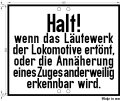Illustration of the traffic signs in the German Reich from 1923 to 1925
The picture table of the traffic signs in the German Reich from 1923 to 1925 shows the traffic signs in the German Reich during the Weimar Republic , show the new version of the 1909 ordinance on motor vehicle traffic , which now came into effect as the ordinance on motor vehicle traffic of March 15, 1923 .
The international warning signs introduced in 1910 remained valid. In 1923, paragraphs 18 and 23, belonging to points C. The driver of the motor vehicle and D. Use of public roads and spaces , dealt with speed limits. In the case of motor vehicles with a total weight of less than 5.5 tons, the speed within built-up areas could no longer be limited to less than 30 kilometers per hour . Regional administrative authorities had the right to increase the inner-city speed to up to 40 kilometers per hour. Vehicles over 5.5 tons were allowed to drive through a town at a maximum of 25 kilometers per hour. In this case, tractors with trailers were not allowed to drive faster than 16 kilometers per hour. Overall, the ordinance of 1923 gives road signs only superficial space, while the number plates, for example, are described in detail.
The law on the traffic with motor vehicles of July 21, 1923 referred in paragraph 5a to the erection of warning signs. According to this, dangerous road sections that were used for through traffic should be secured with warning signs. These included, among other things, level crossings, road bends and curves.
The color tones and typography of the characters were not standardized, so the execution in detail was dependent on the specifications of the German states, the manufacturers and the automobile associations. The texts on the boards could also be designed differently despite official requirements.
Officially prescribed boards
International warning signs
Board for maximum speeds
Barrier boards
Further signage
The further signage of the streets was carried out regionally in many areas and was therefore often very inconsistent.
Local authority initiatives
Automobile Club Initiatives

Since 1912, among other things, the General German Automobile Club has been setting up place-name signs and signposts on a private initiative, as government agencies saw no need to decree modern signage that is suitable for motorists. Most of the time in the 1920s there were still the signposts and signposts from the 19th century, usually made of cast iron .
In the 1920s, the German Touring Club began setting up signposts in the most important German traffic regions. The signs had a uniform design; the lower field was reserved for the companies that had made a financial contribution to the manufacture of the tablet. The Bavarian Automobile Club also set up blue and white warning signs in Bavaria, which in their basic form were based on the state signs for maximum speeds.
Place-name sign of the General German Automobile Club
Warning signs for crossings
The warning signs originally attached by the Prussian-Hessian Railway Association at crossings , the writing of which had to be raised, were retained in their original dimensions after 1918. After the establishment of the Deutsche Reichseisenbahnen from April 1, 1920 and again after the establishment of the Deutsche Reichsbahn-Gesellschaft from August 30, 1924, these tables became valid throughout the Reich.
literature
- Dietmar Fack: Automobiles, traffic and education. Motorization and socialization between acceleration and adaptation 1885–1945. Leske + Budrich, Opladen 2000, ISBN 3810023868
Web links
Remarks
- ^ Reichsgesetzblatt , year 1923, No. 21, date of issue: Berlin, March 23, 1923, p. 175.
- ^ Reichsgesetzblatt , year 1923, No. 21, date of issue: Berlin, March 23, 1923, pp. 180-181.
- ^ The German Touring Club (D. T. C.). From a cyclist's association to a powerful motorist association . In: Deutsche Presse, 20th year (1930), p. 314 ff .; here: p. 315.
- ↑ Ferdinand Loewe, Hermann Zimmermann (ed.): Handbuch der Ingenieurwissenschaften in five volumes , Vol. 4, Der Eisenbahnbau., Engelmann, Leipzig 1913, p. 85.
- ^ W. Cauer: Safety systems in the railway company . In: Reference library for civil engineers. Part 2, Railways and Urban Development, Vol. 7, Springer, Berlin / Heidelberg 1922, p. 422.















